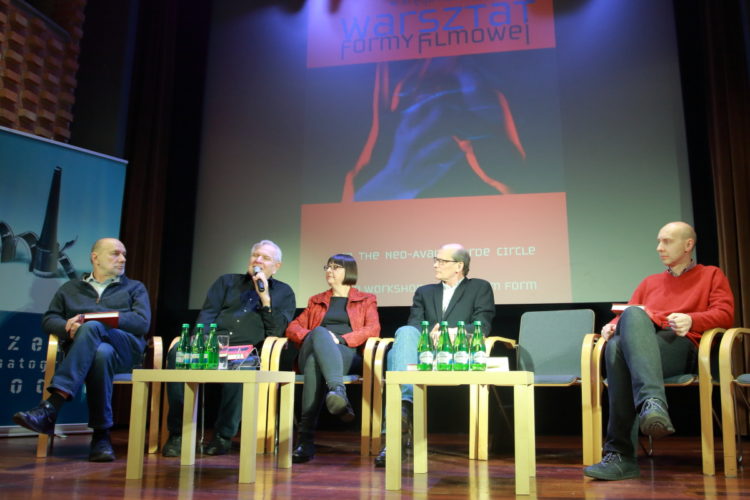In the Neo-avant-garde Circle

The book titled “W kręgu neoawangardy – Warsztat Formy Filmowej” / “In the Neo-avant-garde Circle – the Workshop of the Film Form” (also known as: WFF) edited by Marzena Bomanowska and Alicja Cichowicz is a bilingual, Polish-English publication devoted to the work of the Neo-avant-garde artistic group which functioned in Łódź as a scientific club by the Film School in 1970–1977.
This formation had a decisive impact on the Polish art in the 1970s. and later decades of the 20th century. It was a pioneer group in the context of conceptual artistic practice and analytical art; well-known for its use of specific, Neo-avant-garde strategy of shaking rigid conventions and crossing traditional boundaries of all visual art disciplines.
We invited to cooperate on the publication numerous established and renowned film theoreticians as well as art historians and critics, and the lecturers of universities at the same time: Professor Ryszard Kluszczyński, Lech Lechowicz, Doctor Bożena Stokłosa, Doctor Tomasz Załuski. The authors of the memoirs texts are the former Workshop members: Józef Robakowski and Janusz Połom, as well as the group fan – Zbigniew Wichłacz; the interviews concerning the work with the WFF were given by: Andrzej Barański, Marek Koterski, Grzegorz Królikiewicz, Ryszard Lenczewski and Zbigniew Rybczyński – the Oscar winner for “Tango” which was developed in Łódź. The preface to the book was prepared by the art historian and curator, Anda Rottenberg.
The Workshop members rejected aesthetic approach for the sake of cognitive, intellectual art. They focused on the work of art function and structure, the process of creating and its communicative dimension. They valued highly experiments and assumed practical and theoretical studies. They presented conceptual-analytical attitude, while at the same time acknowledging their ties to Dadaism represented by Stefan and Franciszka Themerson (thus the spirit of irony, contrariness and provocation in their work), as well as Constructivism of Władysław Strzemiński and Katarzyna Kobro. Contrary to its name, the group’s activity covered nearly all art disciplines, also in public space. The Workshop artists created and analysed: experimental films, photographs and also – as pioneers in Poland – video works. Moreover, they created structures, installations, performances, happenings with public participation, multimedia works combining film with other art disciplines.
The Workshop of the Film Form played an invaluable role in the Polish Neo-avant-garde circle. In contrast to many other artistic formations, the group was highly successful. It was invited to festivals and reviews of avant-garde art in the whole Europe, as well as the 12th Art Biennial in São Paulo in Brazil.
The publication, apart from the historical-analytical text concerning the group’s activity, includes also subject-based studies analysing the work of the WFF in selected contexts (e.g. showing the differences in the approach of its individual members to the media they used, or the role of photography in their works). Additionally, the book contains an essay on the reception of the works by the Workshop of the Film Form. The publication is richly illustrated – part of the illustrative material comes from the collection of the Galeria Wymiany of Professor Józef Robakowski. We present reproductions of the Workshop members’ works: photos of experimental films and videos, photo works, structures and installations, as well as documentation on the activities, actions and performances. The publication is accompanied by a DVD containing ten film experiments of crucial importance for the group’s achievement.
The book is intended as a popular/science publication. Its publishers believe it should provide an excellent didactic support for students of many humanistic faculties. Besides the students of art schools such as film and art universities, the publication should be helpful for young experts in culture, art sociologists, anthropologists, etc. We hope that this title will also attract attention of all fans of modern art, in particular those who would like to get more insight into the circumstances of the birth of the Polish Neo-avant-garde.
The book was published in the Year of Avant-Garde, celebrating the 100th anniversary of avant-garde in Poland.
The publication was co-financed by the Ministry of Culture and National Heritage, while the partners of the publisher, the Film Museum in Łódź, are: the Łódź Film School, Łódź Special economic Zone, and companies: ALFAS and EIZO.
